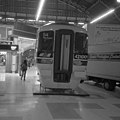Top Qs
Timeline
Chat
Perspective
List of British Rail electric multiple unit classes
British EMU classification system From Wikipedia, the free encyclopedia
Remove ads
This article lists every electric-powered multiple unit allocated a TOPS classification or used on the mainline network since 1948, i.e. British Railways and post-privatisation. For a historical overview of electric multiple unit development in Great Britain, see British electric multiple units.
This article needs additional citations for verification. (January 2025) |
British Rail operated a wide variety of electric multiple units for use on electrified lines:
- AC units operate off 25 kV alternating current (AC) from overhead wires. Where clearances for the overhead wires on the Great Eastern Main Line, North Clyde Line and London, Tilbury and Southend railway routes were below standard, a reduced voltage of 6.25 kV AC was used. The Midland Railway units used 6.6 kV AC. Under the computer numbering, AC units (including mixed-voltage units that can also work off a DC supply) were given a class in the range 300–399.
- DC units operate off 650–850 V direct current (DC) from a third rail on the Southern Region and North London, Merseyside and Tyneside networks. The Manchester-Bury Railway line used 1,200 V DC from a side-contact third rail. The Manchester South Junction & Altrincham and "Woodhead" and initially the Great Eastern Railway routes used 1,500 V DC from overhead wires. Under the computer numbering, DC units were given a class in the range 400–599.
Remove ads
AC EMUs and dual-voltage EMUs
Summarize
Perspective
First generation
Second generation
Modern/Third generation
These use solid state switching devices (thyristors and transistors) and have electronic power control.
High speed trains
High speed multiple unit or fixed formation trainsets, capable of operating at speeds above 190 kilometres per hour (120 mph).[10]
Remove ads
DC EMUs
Summarize
Perspective
Southern Region units
The Southern Railway and its successor, the Southern Region of British Rail, used three letter codes to classify their DC EMU fleets, as shown after the TOPS class numbers. Southern Region EMUs were classified in the 400 series under TOPS.
Pre-Nationalisation

Mark 1 and 2 bodyshell

Tube Stock
Rolling stock built to London Underground deep tube loading gauge.

Note that TOPS class 499 is currently allocated to London Underground owned stock that needs to use Network Rail owned tracks. This does not involve any renumbering of the stock involved, and is only for electronic recording purposes.[13]
Modern EMUs


Other DC units
The 500 series classes were reserved for miscellaneous DC EMUs not from the Southern Region. This included the DC (third/fourth rail) lines in North London, Manchester and Merseyside and the OHLE lines in Greater Manchester. The DC electric network around Tyneside had been de-electrified by the time TOPS was introduced, and the stock withdrawn or transferred to the Southern Region.

- TOPS classes
- Pre-TOPS classes
- Ex-LNER units (Tyneside stock)
- Ex-LNWR units (North London stock)
- Ex-LOR units (Liverpool Overhead Railway stock)
- Ex-LYR units (Manchester-Bury stock)
- Ex-Mersey Railway units (Merseyside DC stock)
- Ex-W&CR units (Waterloo & City Railway stock)
Remove ads
Battery electric multiple unit (BEMU)
The original BEMU was a one-off unit, withdrawn before the introduction of TOPS. A new generation battery EMU (called an Independently Powered Electric Multiple Unit) was created in 2014, converted from a Class 379.[citation needed]
Non National Rail units
All rail vehicles operating on Network Rail infrastructure are required to be given TOPS codes. For this reason, London Underground, South Yorkshire Supertram and Tyne & Wear Metro trains have their own TOPS classes:
Remove ads
See also
- List of British Rail classes
- List of British Rail modern traction locomotive classes
- List of British Rail diesel multiple unit classes
- British Rail locomotive and multiple unit numbering and classification
- SR multiple unit numbering and classification
- British Rail coach type codes
- Electric multiple unit
References
Wikiwand - on
Seamless Wikipedia browsing. On steroids.
Remove ads
























































































































